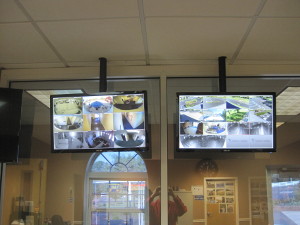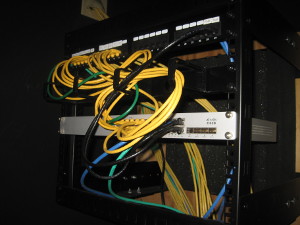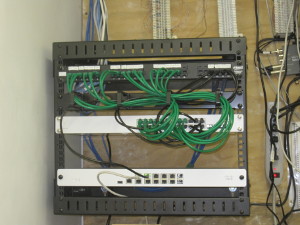 This customer’s original need was for security cameras to cover interior and exterior areas of a growing church. During the site survey, it was noted that their network was utilizing a variety of consumer-grade network devices that would not support an extensive IP security camera system. A project was designed that would upgrade the existing network utilizing Cisco Meraki MX Security Appliance, a variety of Cisco Meraki POE switches, and Cisco Meraki access points. The Cisco Meraki switches would also be used to power the new IP security cameras.
This customer’s original need was for security cameras to cover interior and exterior areas of a growing church. During the site survey, it was noted that their network was utilizing a variety of consumer-grade network devices that would not support an extensive IP security camera system. A project was designed that would upgrade the existing network utilizing Cisco Meraki MX Security Appliance, a variety of Cisco Meraki POE switches, and Cisco Meraki access points. The Cisco Meraki switches would also be used to power the new IP security cameras.
The upgrade to their network provided better network security for their data network as well as a creating a solid platform for the new IP security camera system. The new network components also allowed the setup of separate VLAN (virtual networks) to segregate the IP security camera system from the staff’s data network as well as providing a separate network for volunteers to utilize when they were at the church.
The project was divided into two phases due to the cost of the project. The first phase consisted of the installation of two new wiring closets as well as  the upgrade of two existing wiring closets. New Cisco Meraki network components were installed along with new network trunk lines to tie the new and existing wiring closets together. Wireless access points were also installed throughout the facility. IP security cameras covering the exterior of the structure, parking areas, playground, and main entrances were installed. A NVR (Network Video Recorder) server was also installed. Lastly, two monitors were installed in the office so the security camera feeds could be viewed in the office from the NVR.
the upgrade of two existing wiring closets. New Cisco Meraki network components were installed along with new network trunk lines to tie the new and existing wiring closets together. Wireless access points were also installed throughout the facility. IP security cameras covering the exterior of the structure, parking areas, playground, and main entrances were installed. A NVR (Network Video Recorder) server was also installed. Lastly, two monitors were installed in the office so the security camera feeds could be viewed in the office from the NVR.
 The second phase of the project involved the upgrade of the security features of the MX security appliance along with installing security cameras to cover the interior areas of the church. Overall, the project consisted of a full network upgrade using Cisco Meraki components, installation of over 4000 feet of Cat 6E network cable, APC UPS units, and 23 Vivotek security cameras along with an NVR server that was tied into the network. This was accomplished with the use of DDNS (Dynamic DNS) service and some port forwarding on the router. Upon completion, the staff could than view all their security cameras remotely using an app on their phones and tablets.
The second phase of the project involved the upgrade of the security features of the MX security appliance along with installing security cameras to cover the interior areas of the church. Overall, the project consisted of a full network upgrade using Cisco Meraki components, installation of over 4000 feet of Cat 6E network cable, APC UPS units, and 23 Vivotek security cameras along with an NVR server that was tied into the network. This was accomplished with the use of DDNS (Dynamic DNS) service and some port forwarding on the router. Upon completion, the staff could than view all their security cameras remotely using an app on their phones and tablets.